Il diagramma di Streckeisen: guida all'uso / The Streckeisen diagram: user guide (Italiano-English)
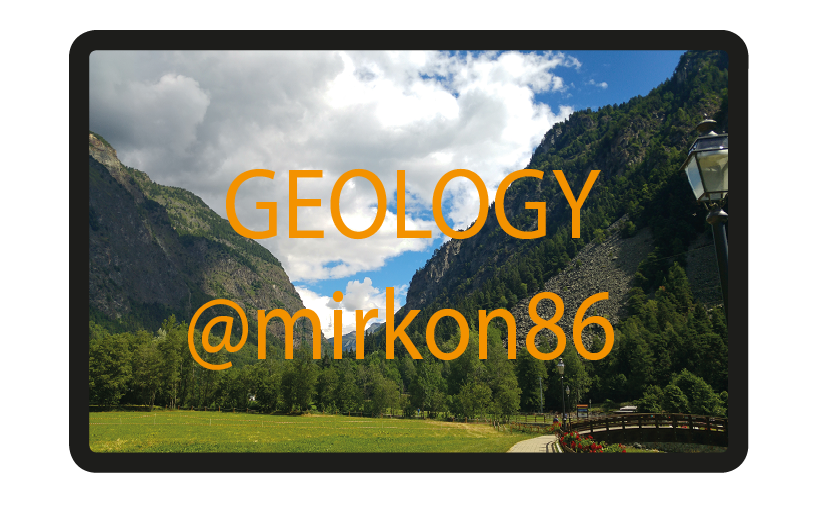

Ciao a tutti! Bentornati nel mio profilo Steemit. Anche oggi torniamo alle basi della Geologia. Sono certo che pochi di voi conoscano il famoso diagramma di Streckeisen. In questo post spiegherò cosa è e a cosa serve. Buona lettura!
Che cos'é il diagramma di Streickeisen?
Quando iniziai il mio corso di laurea in Geologia, proprio nei primi giorni, provai un senso di smarrimento nel vedere questo benedetto diagramma. Può sembrare uno schema complicato e difficilissimo, ma in realtà è più semplice di quello che si potrebbe pensare. Per iniziare, il diagramma ha una forma a rombo con ai vertici alcune lettere: A, Q, P e F. Ovviamente ognuna di queste lettere ha un senso. La lettera A sta per alcalifeldspati, Q sta per quarzo, P per plagioclasi e F per foidi. In A c'è il 100 % di alcalifeldspati e il 0% di P, in P il 100% di plagioclasi e lo 0% di A e stessa cosa tra Q e F.
Mediamente si tiene la relazione Q+A+P=100 %.
Ma ora giunge la domanda: per che cosa viene utilizzato?

Hello to everyone! Welcome back to my Steemit profile. Even today we return to the basics of Geology. I am sure that few of you know the famous Streckeisen diagram. In this post I will explain what it is and what it is for. Enjoy the reading!
What is the Streickeisen diagram?
When I started my undergraduate degree in Geology, in the early days, I felt a sense of bewilderment in seeing this blessed diagram. It may seem like a complicated and very difficult scheme, but in reality it is simpler than what you might think. To begin with, the diagram has a rhombus shape with a few letters at the top: A, Q, P and F. Of course, each of these letters makes sense. The letter A stands for alkalifeldspars, Q stands for quartz, P for plagioclases and F for foids. In A there is 100% alkalifeldspars and 0% of P, in P 100% of plagioclases and 0% of A and the same thing between Q and F. On average, the relationship Q + A + P = 100% is held. But now comes the question: what is it used for?
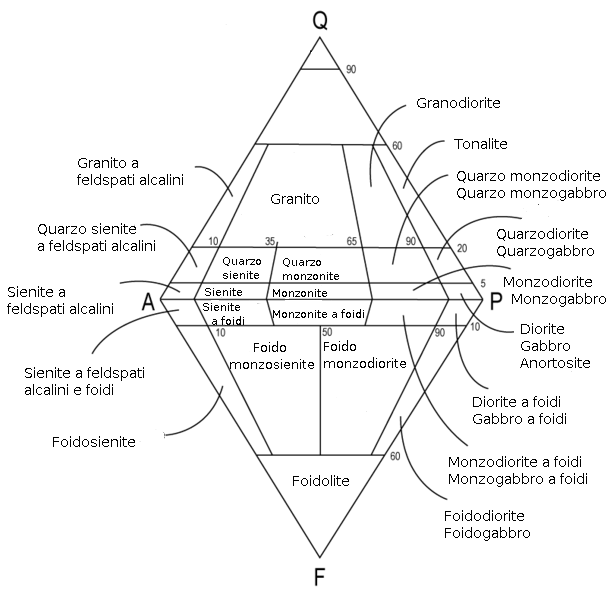
Diagramma di Streckeisen /Streckeisen diagram
LINK:https://upload.wikimedia.org/wikipedia/commons/6/6a/QAPF_plutoniche_italiano.png
Per che cosa viene utilizzato?
Come avete potuto sicuramente vedere dall'immagine, sparsi qua e là ci sono nomi che difficilmente avete sentito parlare. Tali nomi sono tipi di rocce magmatiche intrusive, suddivise con un senso logico all'interno del diagramma (questo diagramma è utilizzabile solo per le rocce magmatiche). Supponiamo di avere una roccia intrusiva come un granito. Il granito è una roccia molto ricca in quarzo e ha un valore abbastanza paritario tra plagioclasio e alcalifeldspati, che sono importanti categorie di minerali. Come potete vedere nel diagramma, il granito si trova in alto (tanto quarzo) e più o meno in centro (più verso A, ma con molto P). Il senso del diagramma è quindi quello di guardare un campione a mano, vedere i tipi di cristalli e andare a vedere cosa è all'interno del diagramma. Facile, no? No, non è facile. Bisogna essere bravi a riconoscere i cristalli e credetemi che molti non sono ovvi poiché spesso i colori prendono in inganno. Proprio per tale motivo, vi farò vedere alcuni esempi delle rocce agli estremi: così potrete poi facilmente capire un minimo le differenze.What is used for?
As you could certainly see from the image, scattered here and there are names that you hardly heard. Such names are types of intrusive magmatic rocks, subdivided with a logical sense within the diagram. In fact this diagram can only be used for magmatic rocks. Suppose we have an intrusive rock like a granite. Granite is a very rich quartz rock and has a fairly equal value between plagioclase and alkalifeldspar, which are important categories of minerals. As you can see in the diagram, the granite is at the top (both quartz) and more or less in the center (more towards A, but with a lot of P). The sense of the diagram is therefore to look at a sample by hand, see the types of crystals and go to see what is inside the diagram. Easy, no? No, it's not easy. You have to be good at recognizing the crystals and believe me that many are not obvious because the colors often mislead. Precisely for this reason, I will show you some examples of the rocks at the ends: so you can then easily understand a minimum differences.
FOTO A: Granito rosa di Baveno / Baveno's pink granite LINK:https://upload.wikimedia.org/wikipedia/commons/c/ca/Rocks_-_Pink_granite_Baveno.JPG
FOTO B: Gabbro Nord appenninico / Northern Appennine Gabbro LINK:https://upload.wikimedia.org/wikipedia/commons/c/cb/Rocks_gabbro_Northern_Apennine_02.JPG
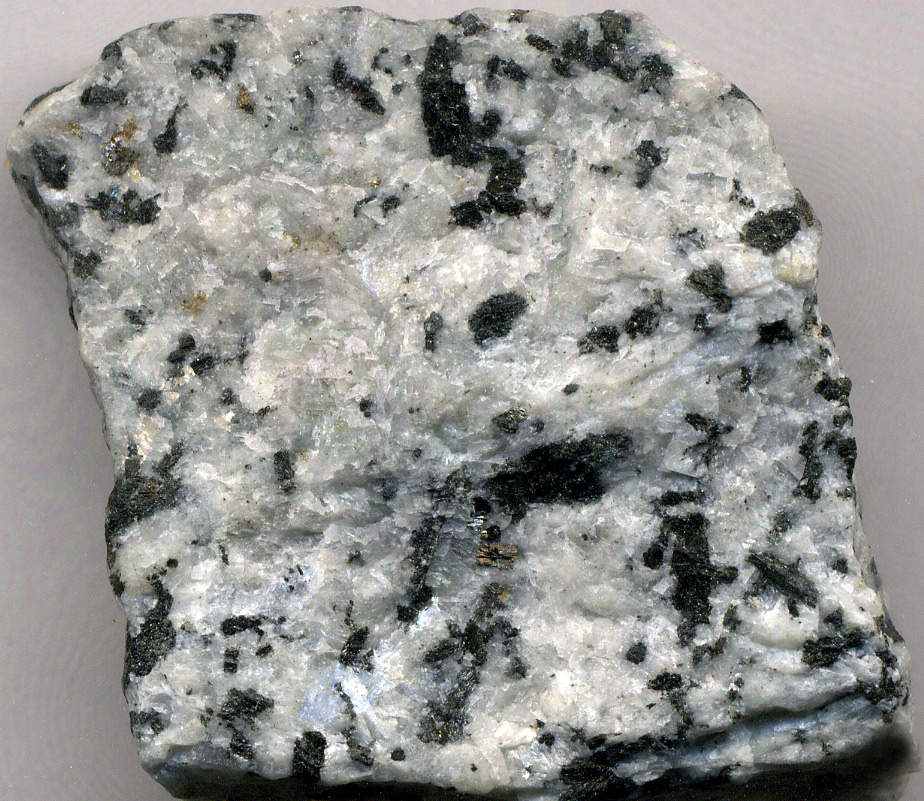
FOTO C: Sienite / Syenite LINK:https://c1.staticflickr.com/9/8640/16563008099_ee58db05b8_b.jpg
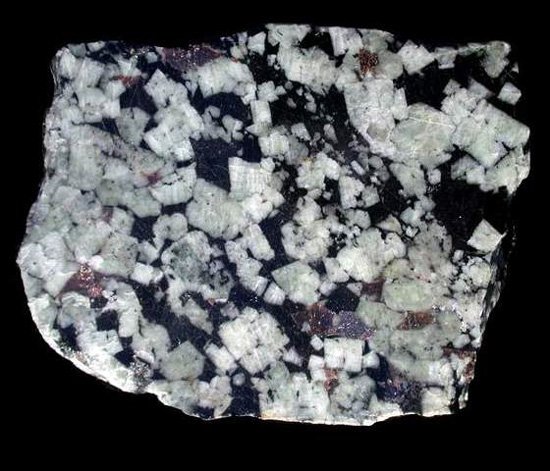
FOTO D: Ijolite
LINK:http://www.alexstrekeisen.it/immagini/diagrammi/ijolite.jpg
Esercizio di analisi riconoscimento rocce
Qual è il modo migliore per fare comprendere questo argomento? Un bellissimo esercizio!Partiamo con la FOTO A. Questa roccia è molto semplice da riconoscere, probabilmente la più semplice. Il granito di Baveno ha la particolarità di essere tendenzialmente rosa. Quel rosa è dato da un minerale che si chiama ortoclasio, ossia un feldspato di potassio (alcalifeldspato). Gli alcalifeldspati come vi avevo detto, si trovano nell'angolo A. Poi potete notare un bianco opaco lattiginoso e un cristallo trasparente. Quello bianco è plagioclasio, mentre quello trasparente è il quarzo. Sapendo ciò, ora si deve ragionare sulle proporzioni di queste componenti: ad esempio potreste dire che c'è tantissimo quarzo, molto ortoclasio e un po' meno di plagioclasio. Nel diagramma saremo quindi in alto verso Q e spostati verso sinistra, tenendoci lievemente centrali. Abbiamo quindi la posizione della nostra roccia nel diagramma.
Ora è il turno della foto B. Questa è ancora abbastanza semplice, ma iniziano a subentrare difficoltà. Come avete letto in descrizione, si tratta di un gabbro e se controllate nel diagramma di Streckeisen potete facilmente notare che vi trovate esattamente al margine di P. Infatti, come vedete dalla foto, la roccia è in gran parte bianca (plagioclasio) con dei cristalli lunghi e verdi. Quei cristalli sono anfiboli e/o pirosseni e sono definiti mafici per il loro alto contenuto in ferro. Il diagramma di Streckeisen, però, ignora i minerali femici, portando così soltanto a calcolare, in questo caso, il plagioclasio. Esistono poi tante varietà di Gabbro, ma esse sono in funzione della variazione della bassa concentrazione di quarzo (c'è sempre quarzo nella metà superiore del diagramma, ma a volte è difficile vederlo!)
Nella foto C iniziano i problemi. La roccia è la sienite ed è tipica del vertice A. Come potete facilmente vedere in questo caso, riuscite a distinguere solo una colorazione nera di alcuni cristalli (cristalli femici) e una colorazione bianca. Ebbene in quella colorazione bianca non c'è solo un minerale. Non è molto semplice in questo caso definire i minerali bianchi, ma ciò è più una questione di esperienza. Sicuramente, se si gira la roccia, si troveranno alcuni punti dove si vede chiaramente la diversità. In ogni caso questi minerali sono il quarzo e l'ortoclasio che stavolta ha un colore naturale bianco (nel caso del granito di Baveno era così per la presenza di ferro).
Infine, nella foto D abbiamo tante difficoltà nel definirgli un nome, ma in compenso facilità nel capire che la roccia è del vertice F. È piena di cristalli particolari, colorati, e ricca di minerali femici. La cosa che però chiarament ci da la prova finale è la mancata presenza del quarzo. Quando manca il quarzo, spesso ci sono i foidi, facilmente riconoscibili da particolari colorazioni (probabilmente i cristalli violetti sono foidi). Automaticamente quando ne manca uno, c'è quasi sempre l'altro. Oltre questo è difficile dire altro a scala macroscopica. Sarò sincero, ma questa roccia è difficile anche per me.
Example of Recognition of rocks
What is the best way to make this subject understand? A beautiful exercise!Let's start with the PHOTO A. This rock is very simple to recognize, probably the simplest. The Baveno granite has the distinction of being pink. That rose is given by a mineral called orthoclase, that is a potassium feldspar (alkalifeldspar). The alkalifeldspati as I told you, are in the angle A. Then you can see a milky opaque white and a transparent crystal. The white one is plagioclase, while the transparent one is quartz. Knowing this, now you have to think about the proportions of these components: for example you could say that there is a lot of quartz, a lot of orthoclase and a little less of plagioclase. In the diagram we will then be at the top towards Q and move to the left, keeping slightly central. We therefore have the position of our rock in the diagram.
Now it is the turn of photo B. This is still quite simple, but begin to take over difficulties. As you have read in the description, it is a gabbro and if you check the Streckeisen diagram you can easily notice that you are exactly on the edge of P. In fact, as you can see from the photo, the rock is largely white (plagioclase) with crystals long and green. Those crystals are amphiboles and / or pyroxenes and are called mafics due to their high iron content. The Streckeisen diagram, however, ignores the femic minerals, thus leading only to calculate, in this case, plagioclase. There are also many varieties of Gabbro, but they are a function of the variation of the low concentration of quartz (there is always quartz in the upper half of the diagram, but sometimes it is difficult to see it!)
In the picture C problems begin. The rock is syenite and is typical of vertex A. As you can easily see in this case, you can only distinguish a black color of some crystals (femic crystals) and a white color. Well in that white color there is not just a mineral. In this case it is not very simple to define white minerals, but this is more a matter of experience. Surely, if you turn the rock, you will find some points where you can clearly see the diversity. In any case, these minerals are quartz and orthoclase which this time has a natural white color (in the case of Baveno granite it was so due to the presence of iron).
Finally, in photo D we have so many difficulties in defining a name, but on the other hand it is easy to understand that the rock is of the F vertex. It is full of particular crystals, colored, and rich in femic minerals. The thing that, however, clearly gives us the final proof is the lack of presence of quartz. When the quartz is missing, there are often foids, easily recognizable by particular colors (probably the violet crystals are foids). Automatically when one is missing, there is almost always the other. Beyond this it is difficult to say anything else on a macroscopic scale. I'll be honest, but this rock is difficult for me too.
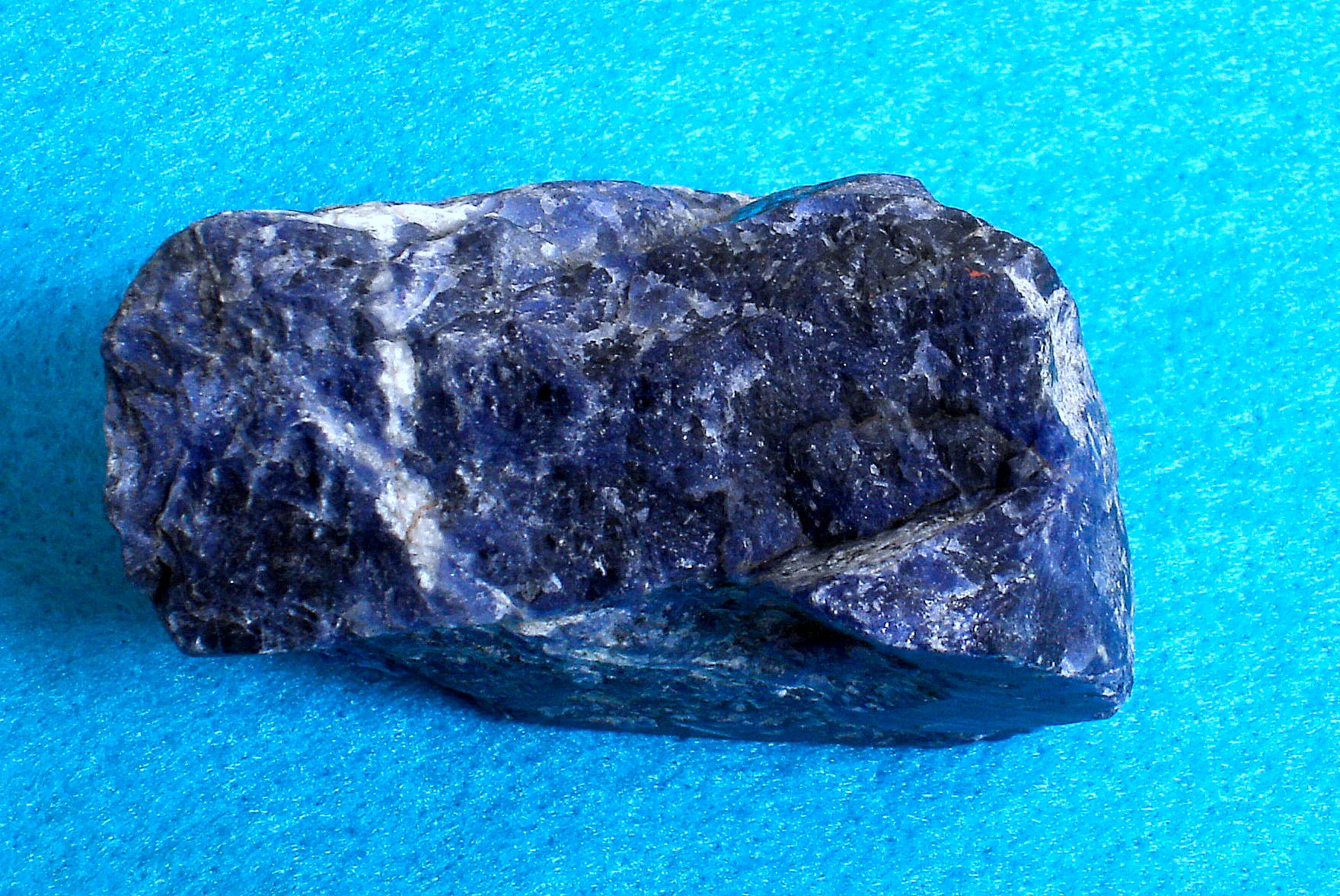 Sodalite: roccia che sta verso il vertice F. I cristalli blu sono foidi / Sodalite: rock that is towards the vertex F. The blue crystals are foids
Sodalite: roccia che sta verso il vertice F. I cristalli blu sono foidi / Sodalite: rock that is towards the vertex F. The blue crystals are foids LINK: https://upload.wikimedia.org/wikipedia/commons/9/99/Sodalite.jpg
Va bene, dopo ciò direi che per oggi è finita qui. Spero che l'argomento sia stato di vostro interesse e vi sia piaciuto. Mi auguro che vogliate lasciare un vostro upvote e i vostri commenti.
Mi saranno molto utili per capire se migliorare qualcosa!
Sono a vostra completa disposizione per chiarimenti.
Grazie a tutti e a presto con i miei prossimi articoli! :)
Okay, after that I would say that for today it's over here. I hope the topic was of interest to you and you enjoyed it. I hope you want to leave your upvote and your comments.
They will be very useful to understand if I improve something!
I am at your disposal for clarification.
Thanks to everyone and see you soon with my next articles! :)
Bibliografia e approfondimenti / Bibliography and insights
https://www.scienzeascuola.it/lezioni/rocce-crosta-terrestre/come-si-usa-il-diagramma-di-streckeisen (link ita)https://it.wikipedia.org/wiki/Diagramma_QAPF (link ita) https://en.wikipedia.org/wiki/QAPF_diagram (link eng) http://www.alexstrekeisen.it/pluto/index.php (link ita) https://earthscience.stackexchange.com/questions/2693/how-do-you-use-the-streckeisen-qapf-classification-ternary-diagram-to-identify (link eng)


caspita! mi stampo i tuoi post e mi faccio una bella raccolta. Ti do un input... un prossimo post potrebbe essere "gli indizi per cercare minerali"
pensaci....
un saluto, nicola
Ma dai! Troppo buono :)
Lo metterò nell'elenco delle cose da fare ^^
Bella spiegazione. Sezioni sottili alla prossima?
Si può fare ^^ Ho anche qualche foto carina che ho fatto al microscopio di granati e olivine.
Adesso vedo come preparare il discorso!
Hah, I remember running into this thing for the first time!
It was my nightmare the first time ahah